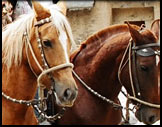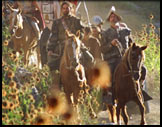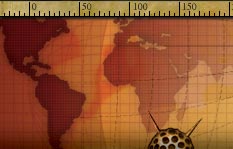 |
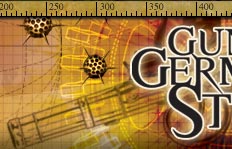 |
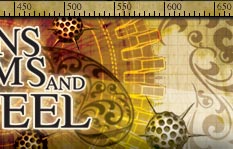 |
 |
||||||||||||||||||||
The Story Of... Horses Domesticated in central Asia around five thousand years ago, the horse was instrumental to the development of Eurasian civilization. Unlike most other large mammals, it was not farmed for its meat, milk or hides. Instead, the horse was harnessed solely for its incredible strength – to pull plows, vehicles, and most significantly, to carry humans themselves.
Spanish horses were instrumental in the conquest of the New World. Neither the Aztec nor the Inca had ever seen humans riding animals before; the psychological impact of mounted troops was tremendous. Hernan De Soto, comrade of Pizarro, famously rode his horse right into the Inca Emperor's throne room. Eyewitnesses later recalled: "The captain advanced so close that the horse's nostrils stirred the fringe on the Inca's forehead. But the Inca remained still, he never moved." Spanish conquistadors like de Soto were inheritors of some of the finest riding techniques in the whole of Eurasia. The jineta riding style, unique to Spanish cattle-ranchers, emphasized spontaneity, speed, balance in the saddle and maneuverability. Bull-fighting, a pastime which grew out of Spanish ranching, also helped riders and their horses improve their techniques of forceful advance and swift retreat. The conquistadors who sailed to the New World had grown up on ranches and farms. They had ridden horses since their youth, and brought their finest animals with them. The consequences for the peoples of the New World were catastrophic.
But the great irony of the conquistadors' victory was that, until about 10,000 years ago, the horse's wild ancestor had flourished throughout the Americas. The plains of North America had in fact been the natural homeland of the Equus species, some of which migrated across a narrow land passage to the plains of central Asia. Then, between 10,000 and 8,000 years ago, the species vanished from the Americas – it is believed, through a combination of over-hunting and climatic change. The submersion of the Bering Strait meant no subsequent, reverse migration could occur from central Asia, and the horse remained absent from the Americas until its reintroduction by Europeans. Where to next? Get more stories about animals including Cattle, Goats, Sheep, Pigs, Llamas, or Zebra. |
||||||||||||||||||||
 |
|
| Variables CROPS - Wheat - Rice - Corn - Sorghum ANIMALS - Cattle - Goats - Sheep - Pigs - Llamas - Horses - Zebra GERMS - Smallpox - Malaria TECHNOLOGY - Steel - Writing GEOGRAPHY - Latitude and Climate - Shape of the Continents - Cities and Civilizations |
|
